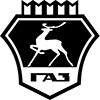 1952 GAZ 69 Dimensions, Size & Specs
1952 GAZ 69 Dimensions, Size & Specs
Measurements of the 1952 GAZ 69, engineered for optimal performance and comfort
| Dimensions | |
|---|---|
| Length: | 3850 mm151.6 in12.6 ft |
| Width: | 1750 mm68.9 in5.7 ft |
| Height: | 1930 mm76.0 in6.3 ft |
| Weight Specifications | |
| Maximal permitted Weight: | 1960-2175 kg4321-4795 lbs |
The GAZ 69 is a classic Soviet off-road vehicle produced from 1953 to 1971. Known for its rugged design and utilitarian purpose, it was widely used by the military and other organizations throughout its production years. The GAZ 69 features a compact yet durable body with a length of 3850 millimeters (approximately 12.63 feet), a width of 1750 millimeters (about 5.74 feet), and a height of 1930 millimeters (roughly 6.33 feet). These dimensions made it practical for navigating challenging terrains while providing sufficient space inside for occupants and cargo. The vehicle's maximum weight ranges between 1960 and 2175 kilograms (4321 to 4795 pounds), reflecting its sturdy build suitable for off-road durability and utility. As an early post-war off-road vehicle, the GAZ 69 embodies a significant period in automotive history, combining functionality with simplicity in design. It remains an important model for enthusiasts interested in Soviet-era military and off-road vehicles, showcasing how car design catered to the demanding needs of off-road conditions during the mid-20th century.
Discover the standout features that make the 1952 GAZ 69 a leader in its class
Have a question? Please check our knowledgebase first.
The GAZ 69, produced from 1953 to 1971, has a length of 3850 mm (approximately 151.6 inches), a width of 1750 mm (about 68.9 inches), and a height of 1930 mm (around 75.98 inches). These dimensions define the vehicle's compact yet sturdy off-road design, allowing it to navigate rough terrain comfortably while maintaining a manageable size for various military and civilian uses.
The GAZ 69's height of 1930 mm (75.98 inches), width of 1750 mm (68.9 inches), and length of 3850 mm (151.6 inches) make it slightly larger in height compared to typical sedans but still compatible with most standard garages. Standard garages usually accommodate vehicles up to around 2 meters (78.7 inches) tall, so the GAZ 69 fits comfortably, although clearance is somewhat limited particularly in height.
The GAZ 69 was not directly preceded by another GAZ off-road vehicle in its class but was developed to meet post-WWII demand for a durable 4x4 vehicle. Compared to pre-war utility vehicles, the GAZ 69 features a more modern and functional design with relatively compact dimensions of 3850 mm length, 1750 mm width, and 1930 mm height. This helped improve maneuverability and off-road capabilities compared to earlier bulky trucks or less specialized vehicles.
The GAZ 69's maximum weight ranges from 1960 kg to 2175 kg (approximately 4321 to 4796 pounds) depending on configuration and equipment. This moderate weight contributes to its ruggedness and durability while retaining decent mobility on rough terrains. Its weight distribution and off-road design allow for good traction and stability, essential for military and utility purposes where reliability under challenging conditions is paramount.
With a width of 1750 mm (68.9 inches), the GAZ 69 is relatively narrow compared to modern SUVs, which often exceed 1900 mm in width. This slender profile allows it to navigate narrow trails and rugged paths effectively, enhancing its versatility as an off-road vehicle. The narrower stance provides an advantage in confined spaces or forested areas, where wider vehicles might struggle to pass.
Compared to contemporaries like the Willys Jeep or the Land Rover Series I, the GAZ 69 is similar in overall dimensions but slightly taller (1930 mm) and similar in length and width. Its dimensions—3850 mm length and 1750 mm width—align it well with these vehicles offering sturdy off-road capabilities. The GAZ 69 was also known for its robustness and simplicity, making it a competitive choice in both military and civilian markets of its era.
The GAZ 69 was designed primarily for utility and troop transport, seating up to four passengers with basic interior accommodations. Its compact exterior dimensions maximize interior space effectively for both passengers and essential cargo. Though not luxurious, the interior is functional, with removable rear seats to expand cargo capacity. This flexibility makes it suitable for carrying personnel or equipment in diverse operational environments.
Standing at 1930 mm (about 76 inches) tall, the GAZ 69 has significant ground clearance and vertical height to handle rough terrain and obstacles. This height supports good approach and departure angles, crucial for off-roading, enabling it to climb and descend steep inclines without chassis damage. However, the taller profile may affect aerodynamic efficiency and may require cautious driving in high-wind conditions.
At 3850 mm (151.6 inches) in length, the GAZ 69 is relatively compact, which helps with maneuverability in confined or mountainous environments. This length allows the vehicle to turn more easily on narrow trails and reduces the chance of getting stuck in tight spots. The compact footprint works well with the 4x4 drive system to provide excellent off-road performance on challenging terrain.
The GAZ 69 was primarily designed as a rugged off-road military vehicle for the Soviet Union and its allies, serving as a light troop carrier, reconnaissance vehicle, and general utility transport. It was widely used in various military and civilian roles including agriculture, forestry, and emergency services, valued for its simplicity, durability, and all-terrain capability. Its adaptability made it a versatile vehicle in several countries during and after its production run.
Discover similar sized cars.

| Production: | 2018-2019 |
|---|---|
| Model Year: | 2018 |
| Length: | 3894 mm153.3 in |
| Width: | 1790 mm70.5 in |
| Height: | 2021 mm79.6 in |
